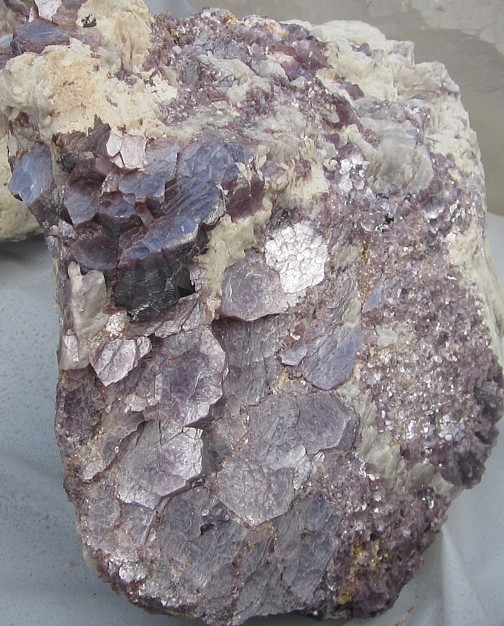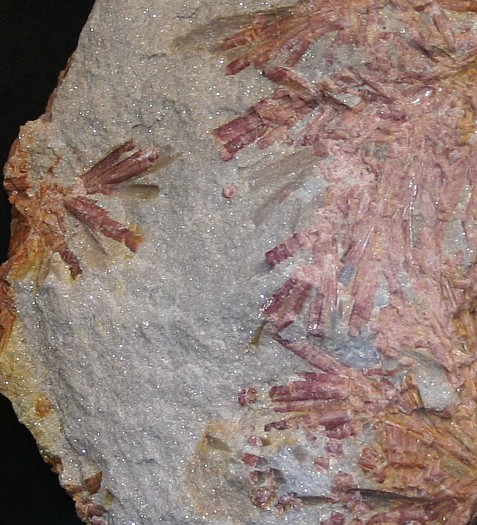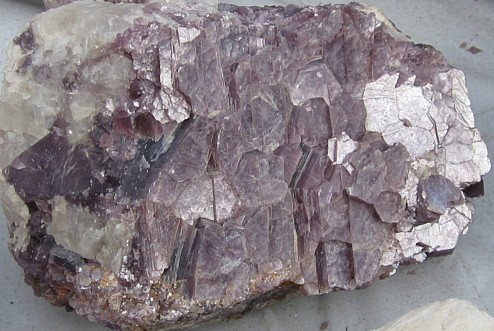|
.
Lepidolite Mineral Facts:
Chemical Formula: KAl2(AlSi3O10)(F,OH)2
A silicate of potassium, lithium
and aluminium, with varying amounts of hydroxyl, fluorine, manganese,
etc.
Colors:
Lepidolite is white, rose or light
purple, gray or greenish.
The
rose and
purple varieties contain a little manganese. The streak
of all
lepidolite is white.
Hardness:
2.5 to 4
Density: 2.8
to 2.9
Cleavage:
Perfect basal cleavage
that is very easily developed as it is in all the Mica minerals.
The cleavage folia are flexible
and
elastic.
Crystallography: Monoclinic
Crystals are usually found in small plates
or prisms with a hexagonal outline. Also commonly found in coarse- to
fine-grained scaly aggregates. Crystals are so poorly developed that a
satisfactory
axial
ratio is difficult to determine.
Luster:.
Vitreous to pearly
luster. It is translucent to transparent.
|

Lepidolite Mica close up |
|
Composition,
Structure and Associated Minerals:
A comparatively rare mineral, Lepidolite is found in the form
of lilac-colored scaly aggregates in pegmatite veins, usually associated
with other minerals of pneumatolytic origin, including pink and green
tourmaline,
topaz,
beryl,
casseterite,
columbite, amblygonite,
spodumene,
etc. Often intergrown with muscovite in parallel position. Cookeite from
Maine and California is probably a form of weathered lepidolite. Its
analyses correspond to the formula, Li(Al(OH)2)3(SiO3)2.
The mineral occurs principally in pegmatites in which rubellite, and other
bright-colored tourmalines exist and on the borders of granite masses and in
rocks adjacent to them. It is often zonally intergrown with muscovite. In
all cases it is probably a pneumatolytic condesation product, and is
produced by the agency of cooling magmatic fluids emanating from a large
igneous body in the final stages of crystalization.
Identification and Diagnostics
Before the blowpipe it is easily fusible
to a white enamel and at the same time coloring the flame a
crimson red lithium shade (positive test for lithium). Usually also gives a
positive reaction for fluorine. It is attacked only with difficultly by
acids being generally considered insoluble, but after heating is
easily
decomposed. Characterized chiefly by its micaceous structure and
lilac to pink color.
Occurrence,
Localities and Origins:
The mineral occurs in nearly all districts
known for producing tin ore, and also in those producing gem tourmaline. Its
best known Eurpoean localities are Jekaterinburg, Russia; Rozna, Moravia;
Schnittenhofen, Bohemia; St. Michael's Mount, Cornwall; and Penig, Saxony.
It has also been mined at the Tanco Mine, Bernic Lake, Manitoba, Canada; and
in Madagascar. In the United States it is found in large quantities at
Hebron, Auburn, Norway, Paris, Rumford and other points in western Maine; at
Chesterfield, Massachusetts; in the tin mines of the southern Black Hills,
South Dakota, and in the tourmaline localities in the neighborhood of Pala,
San Diego County, California.
Uses:
Lepidolite is utilized to a slight extent as a lithium ore for the manufacture of
lithium and lithium compounds, which are employed in a number of industrial
capacities. These include the preparation of including heat resistant glass
and ceramics, lithium medicinal compounds, lubricating grease, lithium metal
alloys, salts used in photography and in
the manufacture of fireworks and lithium ion batteries for the storage of
electric power .
Return to the
Mineral Collectors Information Page
|

Lepidolite Mica and pink Tourmaline, Pala,
California |
|



